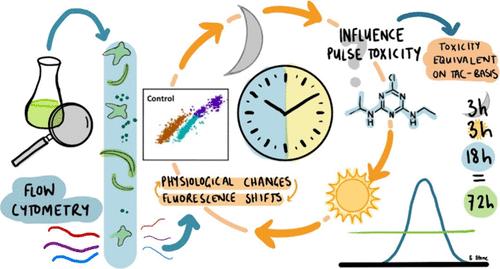当前位置:
X-MOL 学术
›
Environ. Sci. Technol.
›
论文详情
Our official English website, www.x-mol.net, welcomes your
feedback! (Note: you will need to create a separate account there.)
Application of a Multispecies Pulse-Exposure Microalgal Bioassay to Assess Duration and Time-of-Day Influences on the Toxicity of Chemicals
Environmental Science & Technology ( IF 10.8 ) Pub Date : 2024-11-20 , DOI: 10.1021/acs.est.4c07875 Sarah Stone, Darren J. Koppel, Monique T. Binet, Dianne F. Jolley, Stuart L. Simpson
Environmental Science & Technology ( IF 10.8 ) Pub Date : 2024-11-20 , DOI: 10.1021/acs.est.4c07875 Sarah Stone, Darren J. Koppel, Monique T. Binet, Dianne F. Jolley, Stuart L. Simpson

|
Aquatic organisms may frequently be exposed to short-term discharges of contaminants, including those from pesticide use, stormwater runoff, or industrial effluents entering waterways. Here, a new microalgal multispecies flow cytometry-based bioassay is used to assess knowledge gaps in risk assessments posed by the short-term exposure of organisms to contaminants. The toxicities of atrazine, metolachlor, and copper were assessed using four exposure scenarios, a 72 h exposure (continuous), an 18 h pulse exposure, and two 3 h pulse exposures (light and dark conditions), that assessed chronotoxicity. The influence of duration on toxicity explored the utility of two expressions of chemical-exposure dose: pulse-exposure concentration (PeC) and time-weighted average concentrations (TACs). The three coexisting microalgae (Monoraphidium arcuatum, Nannochloropsis-like sp., and Pediastrum duplex) tolerated higher concentrations for shorter 3 and 18 h pulses compared to continuous 72 h exposures. Toxicity estimates calculated on a TAC basis were effective for predicting the toxicity of the pulses of atrazine, metolachlor, and copper. Fluorescence data collected using flow cytometry were linked to physiological diel changes for each species. Chronotoxicity was observed for copper with two species. While continuous contaminant exposures provide a conservative estimate of toxicity compared to pulses, the duration and time of exposure are critical factors to consider when assessing the toxicity of contaminants to microalgae.
中文翻译:

应用多物种脉冲暴露微藻生物测定法评估持续时间和一天中的时间对化学品毒性的影响
水生生物可能经常暴露在短期排放的污染物中,包括来自杀虫剂使用、雨水径流或进入水道的工业废水的污染物。在这里,一种新的基于微藻多物种流式细胞术的生物测定法用于评估生物体短期暴露于污染物造成的风险评估中的知识差距。使用四种暴露场景评估阿特拉津、异丙甲草胺和铜的毒性,即 72 小时暴露(连续)、18 小时脉冲暴露和两次 3 小时脉冲暴露(光照和黑暗条件),以评估时间毒性。持续时间对毒性的影响探讨了化学暴露剂量的两种表达方式的效用:脉冲暴露浓度 (PeC) 和时间加权平均浓度 (TAC)。与连续 72 小时暴露相比,三种共存的微藻 (Monoraphidium arcuatum、Nannochloropsis-like sp. 和 Pediastrum duplex) 在较短的 3 小时和 18 小时脉冲中耐受更高的浓度。基于 TAC 计算的毒性估计值可有效预测阿特拉津、异丙甲草胺和铜脉冲的毒性。使用流式细胞术收集的荧光数据与每个物种的生理 diel 变化有关。观察到两种铜的计时毒性。虽然与脉冲相比,连续污染物暴露提供了对毒性的保守估计,但在评估污染物对微藻的毒性时,暴露的持续时间和时间是需要考虑的关键因素。
更新日期:2024-11-20
中文翻译:

应用多物种脉冲暴露微藻生物测定法评估持续时间和一天中的时间对化学品毒性的影响
水生生物可能经常暴露在短期排放的污染物中,包括来自杀虫剂使用、雨水径流或进入水道的工业废水的污染物。在这里,一种新的基于微藻多物种流式细胞术的生物测定法用于评估生物体短期暴露于污染物造成的风险评估中的知识差距。使用四种暴露场景评估阿特拉津、异丙甲草胺和铜的毒性,即 72 小时暴露(连续)、18 小时脉冲暴露和两次 3 小时脉冲暴露(光照和黑暗条件),以评估时间毒性。持续时间对毒性的影响探讨了化学暴露剂量的两种表达方式的效用:脉冲暴露浓度 (PeC) 和时间加权平均浓度 (TAC)。与连续 72 小时暴露相比,三种共存的微藻 (Monoraphidium arcuatum、Nannochloropsis-like sp. 和 Pediastrum duplex) 在较短的 3 小时和 18 小时脉冲中耐受更高的浓度。基于 TAC 计算的毒性估计值可有效预测阿特拉津、异丙甲草胺和铜脉冲的毒性。使用流式细胞术收集的荧光数据与每个物种的生理 diel 变化有关。观察到两种铜的计时毒性。虽然与脉冲相比,连续污染物暴露提供了对毒性的保守估计,但在评估污染物对微藻的毒性时,暴露的持续时间和时间是需要考虑的关键因素。


















































 京公网安备 11010802027423号
京公网安备 11010802027423号